Last Updated on January 27, 2025 by Owen McGab Enaohwo
![What is the Offboarding Process: [How to Do It + Free Checklist]](https://www.sweetprocess.com/wp-content/uploads/2025/01/offboarding-process-1024x576.png)
Employee turnover is a natural part of any business. But what happens when it’s time for an employee to leave?
Do you simply revoke their access to company systems or provide a smooth transition?
In 2024 alone, over 500 big tech organizations laid off more than 140,000 employees, highlighting the growing importance of managing employee exits effectively. Many small business owners overlook the importance of an effective offboarding strategy, missing opportunities to gather valuable feedback, secure company assets, and ensure smooth transitions.
Although they are leaving, these departing team members can still be influential ambassadors for your company. But only if your company has a proper offboarding process in place. Without one, you risk chaotic endings that could negatively impact your brand and team morale for the remaining employees.
So, what does a well-executed offboarding process look like?
In this guide, we’ll break down the offboarding process, explain why it matters, and show you how to implement a seamless offboarding experience to keep your business running smoothly.
What You’ll Learn In This Guide:
What Is the Employee Offboarding Process?
Why Is Employee Offboarding Important?
11 Best Practices for an Employee Offboarding Process
How to Offboard Outgoing Employees Using SweetProcess
Benefits of Employee Offboarding Process in an Organization
6 Common Employee Offboarding Mistakes to Avoid
Employee Onboarding vs. Offboarding Process: How Do They Differ?
Manage Your Employee Offboarding Process in One Single Place
What Is the Employee Offboarding Process?

The employee offboarding process includes the steps an organization follows when a team member departs, whether voluntarily or involuntarily. This process ensures a smooth transition and minimizes employee and company disruption.
Organizations with a structured offboarding process can maintain a positive relationship with former employees even after they leave. It’s good practice to offboard all employees, whether they resigned, were terminated, or retired.
Some of the key steps in the offboarding employee process include:
- Knowledge transfer: You should document and transfer critical knowledge from the departing employees for a smoother transition.
- Exit interviews: These meetings are an opportunity to gather feedback on the employee’s experience and reasons for leaving.
- Company assets return: Employees must return company property such as laptops, badges, and keys.
- Final pay: The company settles outstanding payments, benefits, or reimbursements.
Why Is Employee Offboarding Important?

In the same way you follow an employee onboarding process when recruiting new hires, you should have a proper system when it’s time to leave. Here’s why employee offboarding matters:
Protects Your Company’s Brand
A report by Glassdoor shows that 86% of employees and job seekers will evaluate a company’s ratings and reviews before sending an application. Therefore, if your offboarding process is negative, former employees could leave bad reviews discouraging top talent from applying.
It just takes a few comments on social media to tarnish your name. Keep in mind that their experience can shape how others perceive your brand.
A simple process like an exit interview can ensure that employees leave on good terms, preserving your company’s reputation.
Reveals Pain Points
You might be curious why an employee is retiring early or resigning.
Were they having a bad employment experience? Did management provide enough support? What could have been done differently?
These are some of the questions to ask at exit interviews. When leaving the company, employees may feel comfortable sharing frustrations about workplace culture, management practices, or operational inefficiencies. This valuable insight can highlight areas for improvement.
Gathering feedback during offboarding allows your business to address these pain points before they become bigger problems. For instance, if multiple employees point out similar challenges, it may signal an underlying issue that needs to be addressed.
Leaves the Door Open for Boomerang Employees
Boomerang employees leave a company and then return to work for the same organization after a while. This trend has become increasingly common. In fact, according to the Harvard Business Review, over a quarter of the new hires are boomerang employees.
Providing a positive offboarding employee experience encourages former employees to rejoin the company when new opportunities arise. They’ll remember your company as a great place to work even after they leave.
Additionally, the onboarding process will be easier because they know every company process.
Maintain Organizational Knowledge
Employees often take years of institutional knowledge with them when they leave. For instance, a team member who has been with the company for five years understands different aspects of the business. Failure to capture this affects the continuity of your operations.
The experienced employee could train their replacement as part of your offboarding process. You also need a knowledge management system to document all the processes, workflows, and insights to ensure your business doesn’t lose valuable information.
Enhances Compliance With Industry Regulations
Many companies have encountered legal trouble due to wrongful termination cases. Failure to follow the right procedures during offboarding can put your business at risk. You could end up paying fines for not finalizing the process correctly.
Additionally, during offboarding, you should protect sensitive information and return all company equipment to prevent costly security breaches. Companies have faced severe data breach penalties because they didn’t properly revoke access for former employees. A clear and structured offboarding process can help avoid such situations.
11 Best Practices for an Employee Offboarding Process

Now that we’ve established why it’s important to have an employee offboarding process, what should you consider when creating one? Here are 11 best practices to help you manage the offboarding process effectively:
Notify Relevant Teams
Before the employee leaves, they must receive their final pay, hand over company equipment, and transfer their responsibilities. For this transition to be seamless, you should notify the relevant internal teams such as:
- Human resources: To prepare the final paycheck and benefits paperwork
- IT: To revoke access to internal systems
- Department heads and supervisors: To reorganize the teams and assign responsibilities to their successor
Notifying your teams early allows them to organize their actions and ensure no critical tasks are overlooked.
Communicate the Employee’s Departure
Once the relevant teams are informed, it’s time to communicate the departure to the rest of the company. Be transparent but respectful of the employee’s privacy. Publicly acknowledging the departure (if appropriate) helps prevent workplace gossip, which can lead to unnecessary confusion and anxiety among remaining employees.
It’s important to ensure everyone understands why the employee is leaving and who will assume their responsibilities. A clear and respectful communication approach minimizes any negative impact and reassures employees about the team’s stability.
Conduct an Exit Interview
Every employee holds critical information about your business. Therefore, you should conduct an exit interview no matter how long they have been with the company. Prepare a list of exit interview questions to collect information about their experience.
This is an opportunity to uncover any issues and challenges offboard employees face, whether with management, team dynamics, or work processes. For instance, if an employee reveals that they are resigning due to insufficient growth opportunities, you could use this information to create better development programs.
Retrieve Company Property
All company property should be retrieved before the employee’s last day. This includes everything from:
- Laptops
- Mobile phones
- Access cards
- Office keys
- Uniforms
This also includes intellectual property or any proprietary data the employee may have access to, whether physical documents or digital files. Failure to retrieve company property on time can lead to unnecessary losses and security risks.
Terminate Access and Permissions
It’s now common for companies to use software or a business system to run operations. Unfortunately, some former employees still have access to organizational data even after leaving due to poor offboarding processes. This exposes your business to potential data breaches.
You need to revoke access to the internal systems, email accounts, cloud storage, and company data immediately to reduce the risk of security vulnerabilities.
Transfer Knowledge
When long-term or high-level employees leave, they may take vital knowledge with them. However, you can ensure continuity by implementing a knowledge transfer process. Adopt a knowledge management tool as part of your effective offboarding process and encourage the departing employees to document their key responsibilities, ongoing projects, insights, and important processes.
This way, the designated successor can pick up where the employee left off because they have a reference point.
Provide Support and Assistance
The transition is not an easy process. Employee departures can be emotionally charged for both the departing team member and their colleagues. You can draft a recommendation letter to make it easier for them to find a new job.
Here’s a brief example of a recommendation letter:
To Whom It May Concern,
I am pleased to recommend [Employee’s Full Name], who has worked at [Company Name] as a [Job Title] for [the past X years]. During their time with us, [Employee’s Name] consistently demonstrated professionalism, dedication, and a strong ability to manage projects efficiently.
[Employee’s Name] significantly contributed to our team, particularly in [specific example]. They are a team player, detail-oriented, and highly reliable.
Although we are sad to see [Employee’s Name] leave, we are confident they will bring the same level of commitment and excellence to their next role. I wholeheartedly recommend them for any future opportunities they may pursue.
Should you require additional information, please do not hesitate to contact me at [Your Email Address] or [Phone Number].
Sincerely,
[Your Full Name]
[Your Job Title]
[Company Name]
[Company Contact Information]
Offering assistance during offboarding helps the employee feel valued, even if they are leaving, which can turn them into a future advocate for your business.
Complete the Necessary Paperwork and Administrative Tasks
While paperwork can be tiresome, it’s necessary. Include all the final paychecks, benefits settlements, and tax-related documentation. Review the contracts to ensure that everything is in order.
You can avoid legal or financial issues when these administrative tasks are done promptly. It also prevents any last-minute issues that could sour the employee’s departure.
Develop a Short-Term and Long-Term Plan for Coverage
With the employee gone, who is covering their duties?
In these cases, you might have a replacement within the team or need to hire a new employee to take over the role. To minimize disruptions, it’s essential to have a plan, both immediately and in the long term. Include timelines for hiring or reassigning tasks to ensure no crucial responsibilities are left behind.
In the short term, you can redistribute their responsibilities among other team members or hire a temporary replacement. Then, you can start looking for a permanent replacement or restructuring the team if necessary.
Update Your Organizational Charts
It’s important to update your organization chart to reflect the changes in your team structure. For instance, if a manager or executive leaves and you replace them with another employee, this should be updated as soon as possible.
This practice keeps everyone informed about who is responsible for specific tasks or teams. It also reduces confusion, as everyone knows who to report to from now on.
Generate Good Faith
End the relationship on a positive note. Remember that the leaving employee can become a future advocate for your brand. Offer support during the last days and appreciate their time with the company.
Companies with positive environments and strong alumni networks benefit more from boomerang employees who return to work after a brief departure.
How to Offboard Outgoing Employees Using SweetProcess
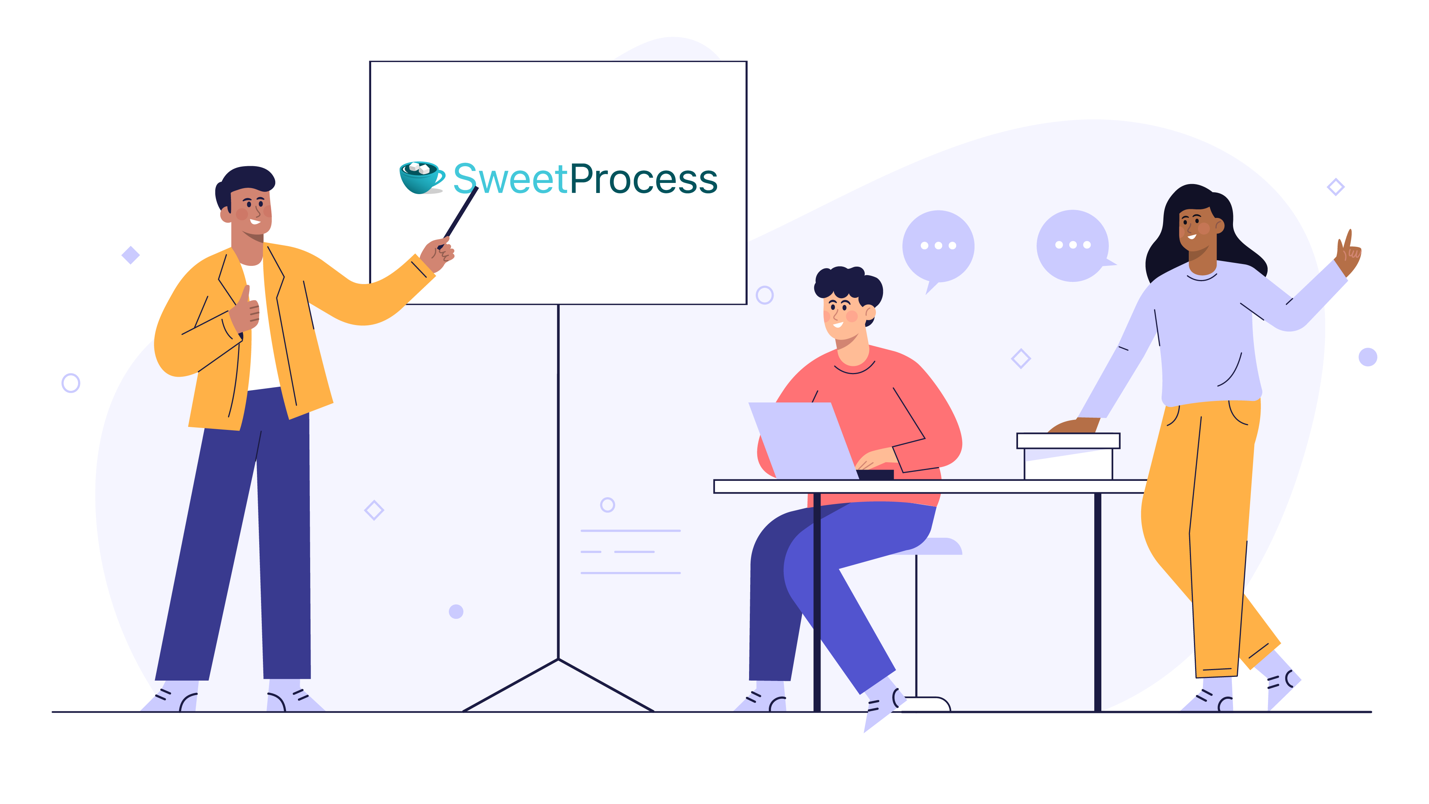
Managing the offboarding process will help you streamline operations and protect your company’s resources. What if you had the right tool? SweetProcess fits perfectly by giving you a platform to document, track, and manage every step in a structured and efficient manner.
Here’s how to offboard outgoing employees using SweetProcess:
Document Your Company’s Procedures, Processes, and Policies to Avoid Tribal Knowledge
Without proper documentation, knowledge is often passed down informally, leading to inefficiencies and errors. Tribal knowledge is rarely documented, yet it’s vital for the company. It can include processes, procedures, best practices, and unwritten rules that employees have learned over the years.
SweetProcess allows you to easily document this information to be accessible after the employee leaves. Here’s how:
To document procedures:
- Open your SweetProcess account.
- Head to the “Procedures” section and select “Create Procedure.”

- Add your title for easy identification.
- Add the procedure to teams.

- Add more details to your procedure. This can be images, tables, or videos.
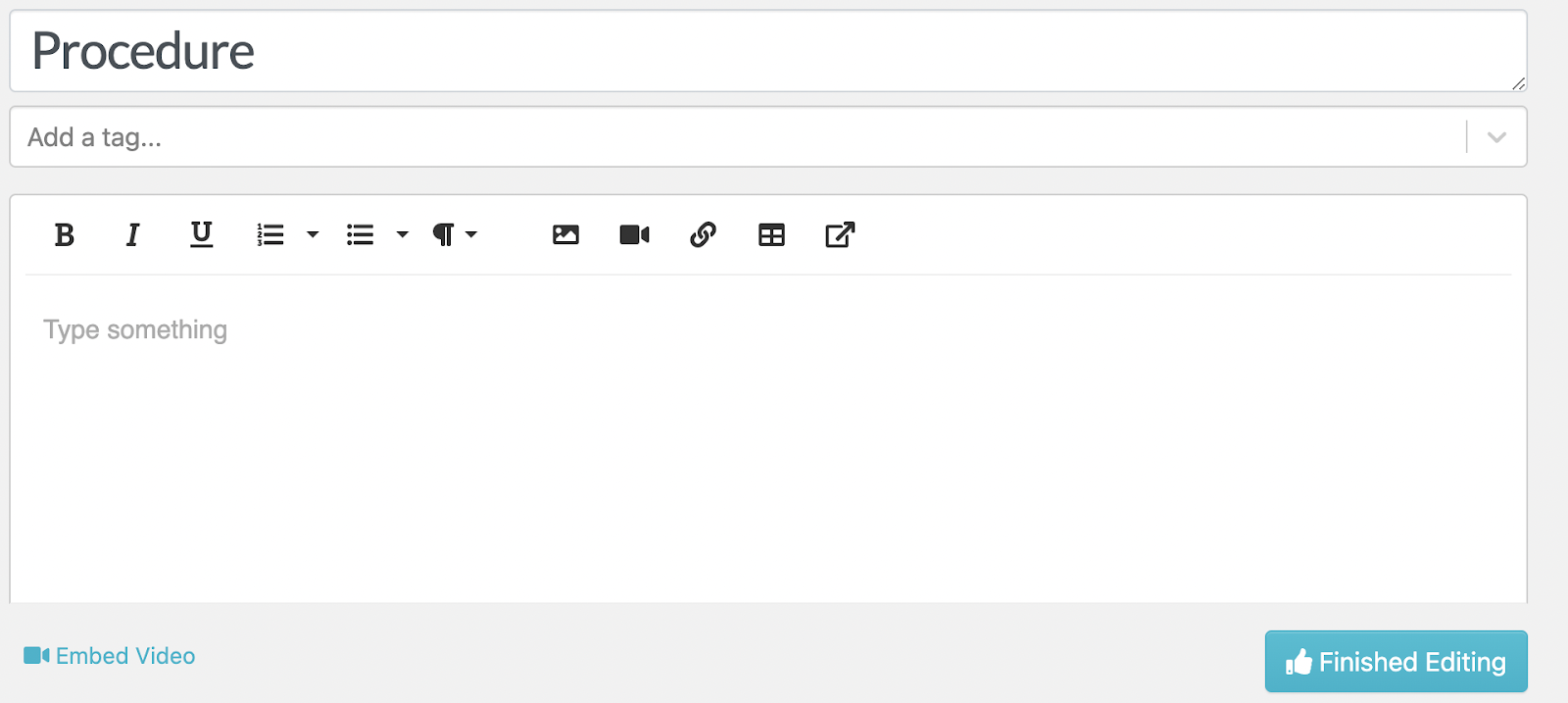
- Once you add all the details, click “Finished Editing.”
You can also use SweetAI to draft the procedure much faster. After adding the title, choose the option to use AI.

To document your process on SweetProcess, follow these steps:
- Open “Processes.”
- Select “Create Process.”

- Name your process.
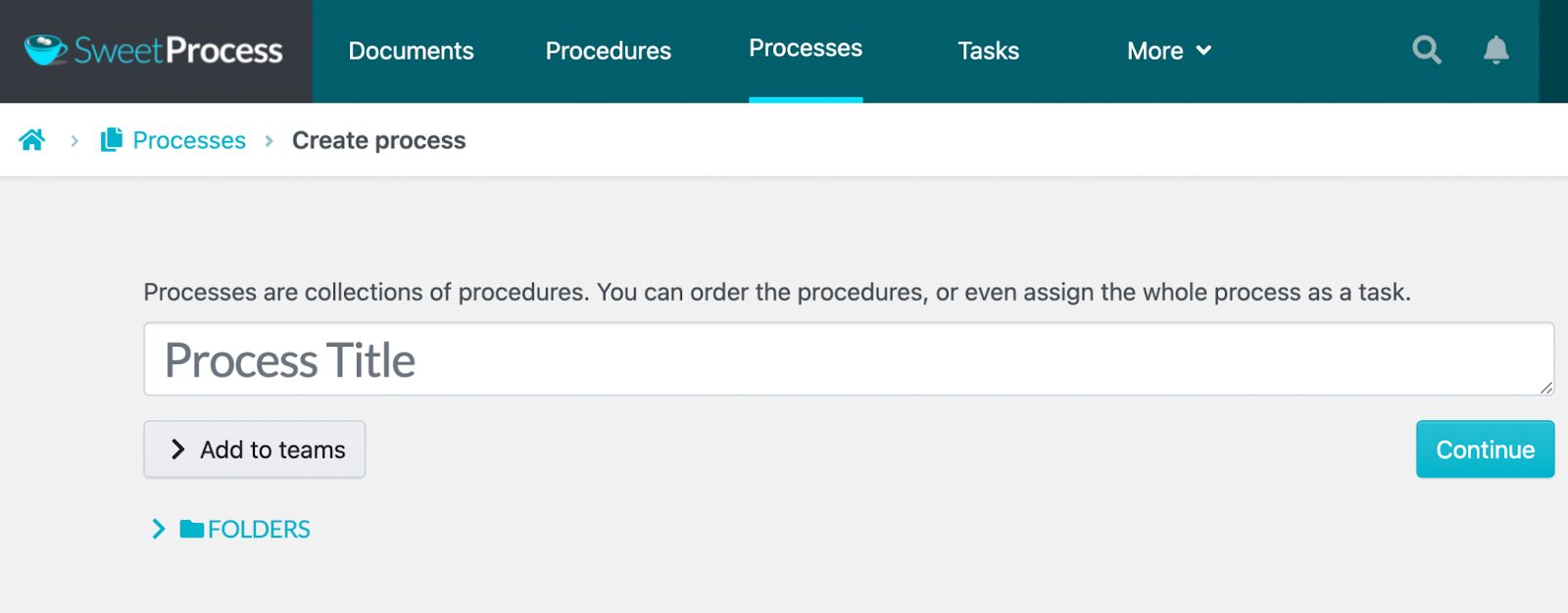
- Add extra details and include relevant visuals.

- Save your changes and click “Finished Editing.”
To document your company policies, follow these steps:
- Click “More” on the main menu.

- Select “Policies.”

- Click “Create Policy.”

- Name your policy.

- Add the policy to company teams and click “Continue.”

- Make your policy comprehensive on the next page by adding details.
- Save changes.

Create an Effective Offboarding Checklist That’s Easy to Follow
An offboarding checklist ensures that all necessary steps are completed when an employee leaves. With SweetProcess, you can track all the tasks and create a customized checklist for your business. Follow these steps:
- Click on the “Processes” tab on the dashboard.

- Add the process, “Employee Offboarding,” and assign it to specific teams.
- Click “Continue.”

- Make the process comprehensive by including more information and adding steps on the next tab.
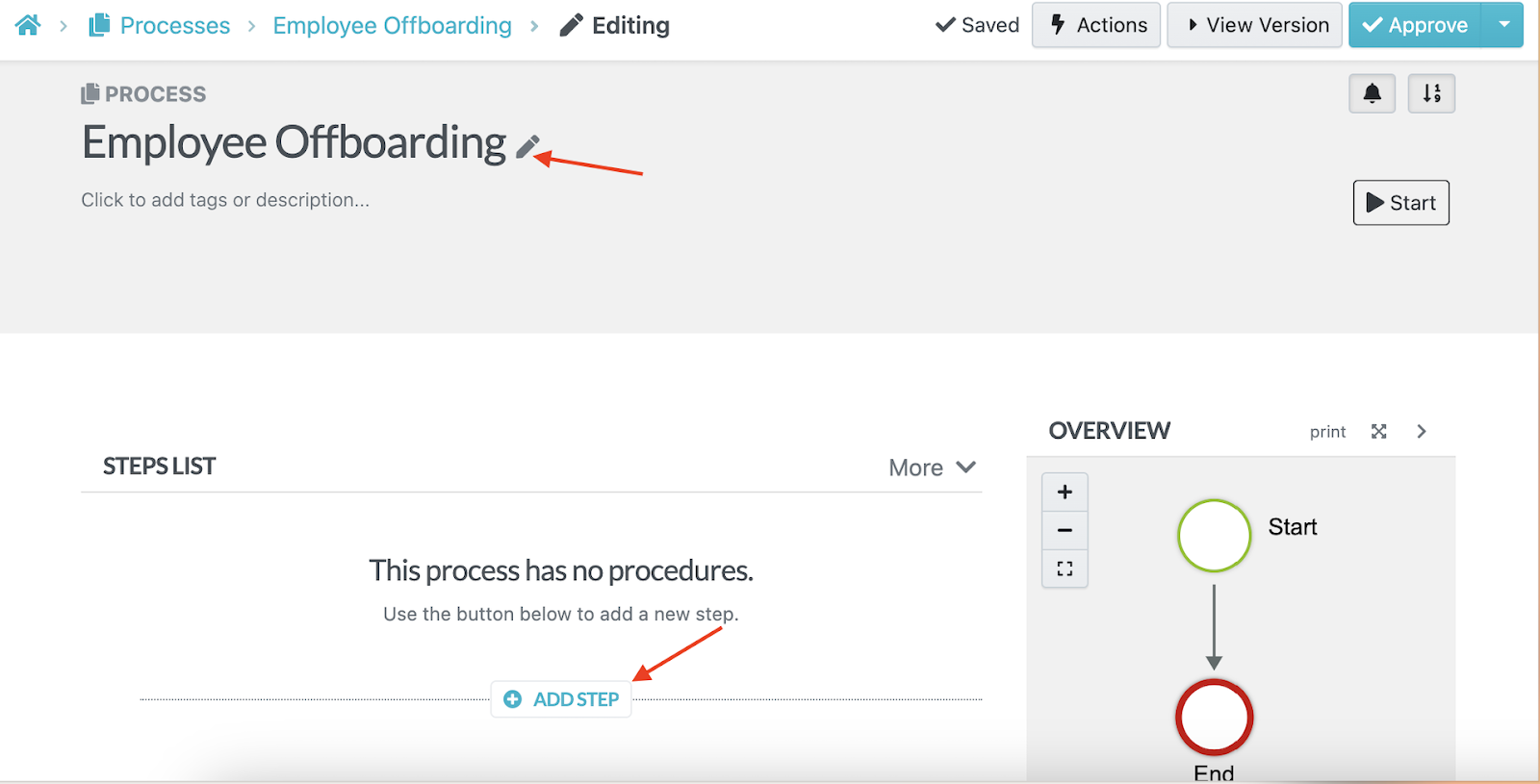
- Add all your steps to create a detailed checklist.
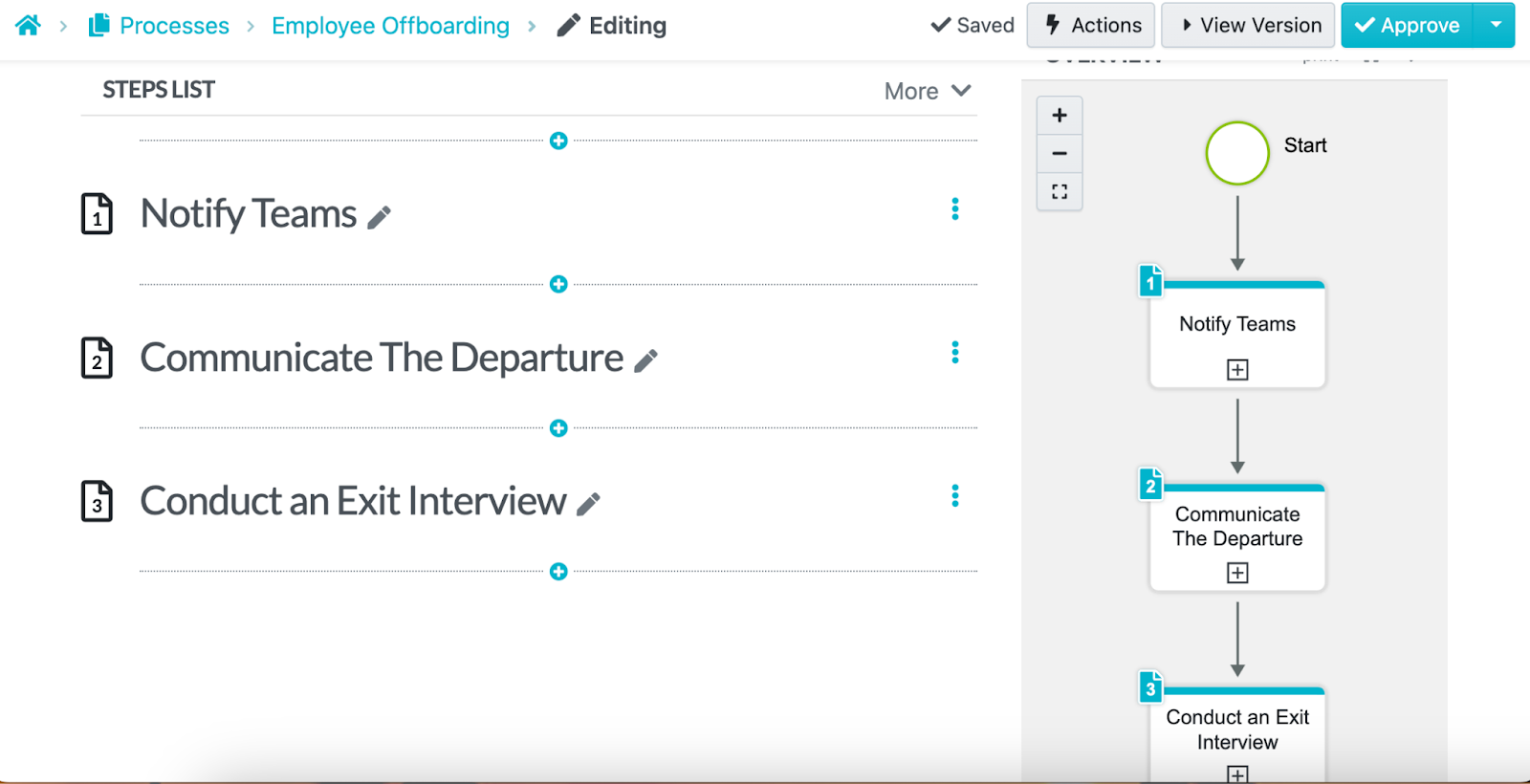
- Once done, share the process with the relevant managers for approval.

Close Your Company’s Knowledge Gap With a Beautiful Knowledge Base
SweetProcess enables you to maintain a knowledge base so your company won’t have to scramble to fill the void left by departing employees. All team members can contribute to the knowledge base, which centralizes critical project, system, or process information.
- Click “More” at the top menu.
- Select “Knowledge Bases.”
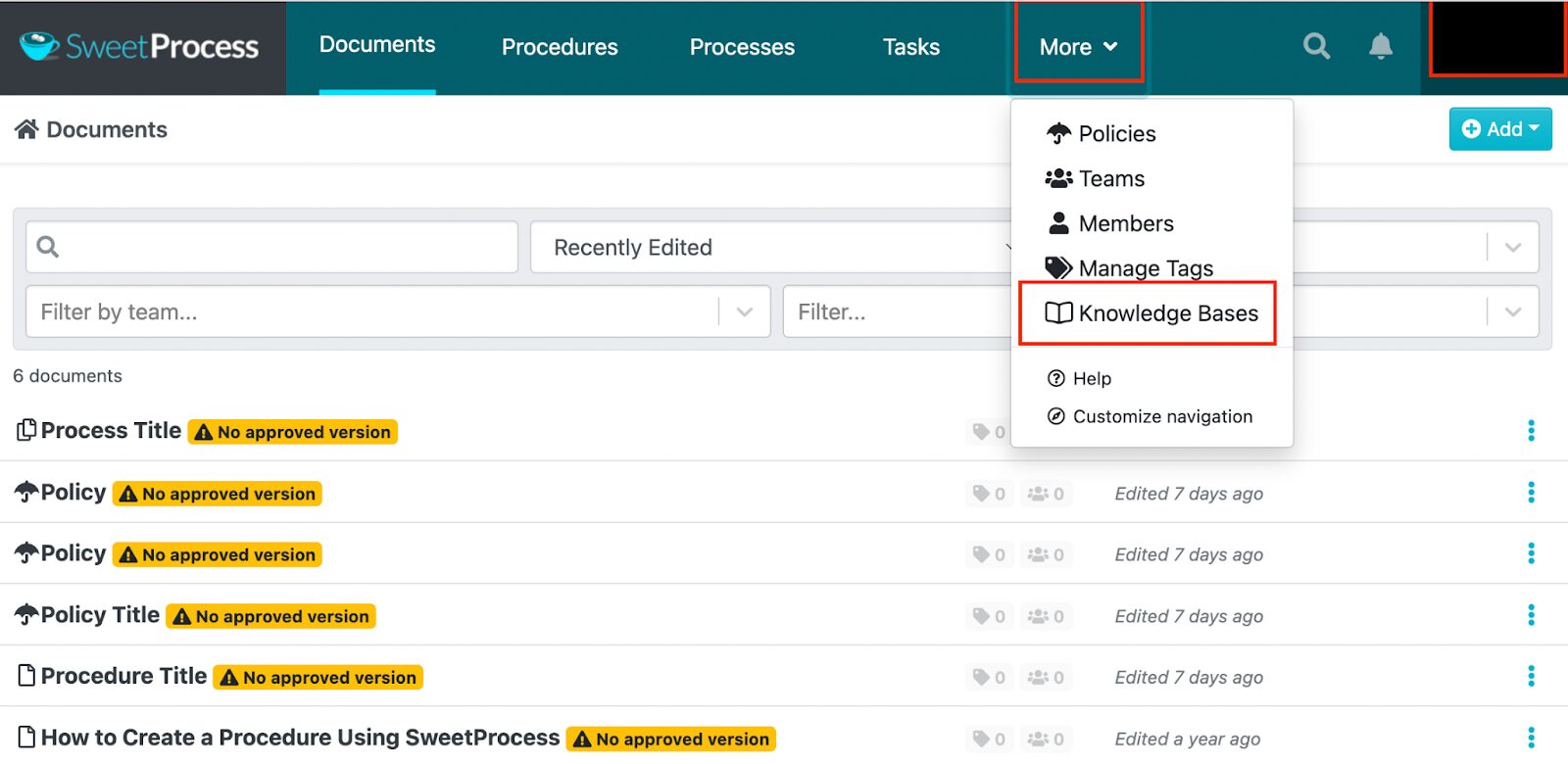
- Select “Create Knowledge Base.”

- Name your knowledge base and click “Continue.”

- Tap the pencil icon to add more information to your knowledge base.
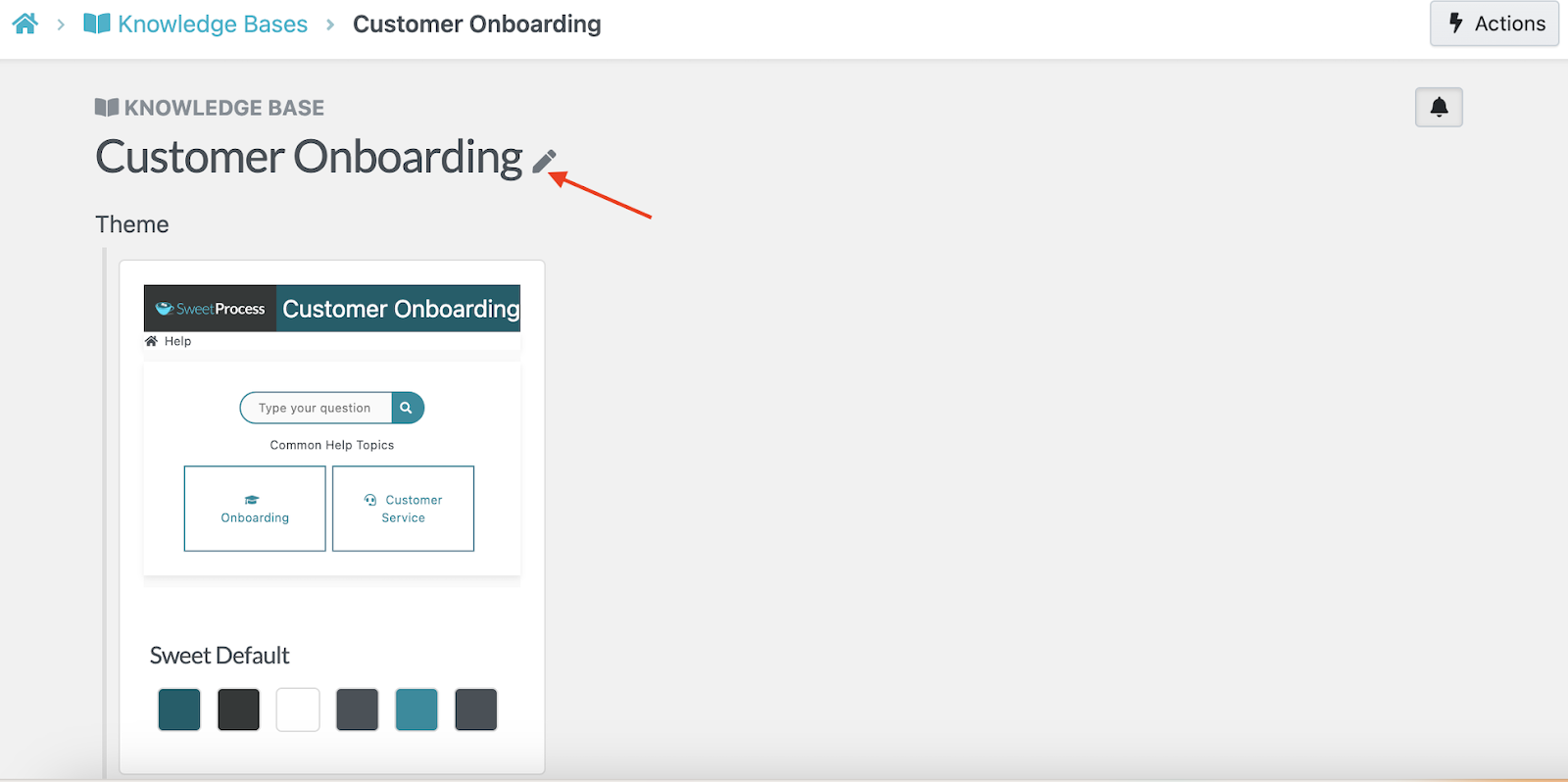
- Scroll down to the “Control Access” section and select the private option since it’s meant for internal teams.

- If the departing employee wants to update an existing knowledge base, they can do so directly on SweetProcess.
- You can implement changes by selecting the specific knowledge base that needs to be updated. Click the three dots on the right, and then implement the changes.

Revoke Outgoing Employee’s Access to Your Company’s Internal Documents
As mentioned, revoking access to an outgoing employee protects your sensitive information data, accounts, and internal documents. Here’s how to use SweetProcess for this:
- Open the “More” tab at the top.
- Select “Members” to view all your employees on the account.

- The list of members will be displayed on the next page.
- Scroll to the employee you want to revoke access, click the three dots on the right, and pick the action.

Some companies have used SweetProcess to manage their offboarding process.
Thimbleberry Financial is a financial planning and wealth management firm that helps clients achieve their financial goals through personalized services. Led by Amy Walls, the company needed a way to improve internal processes and manage employee turnover.
However, the team previously documented using Microsoft Word, so they struggled to access and follow the processes. In addition, high employee turnover led to inconsistencies in task management, especially with team members wearing multiple hats and unclear documentation.
Any adopted SweetProcess after a recommendation from her business coach. The software brought so much value to the company in the following ways:
- Improved onboarding & training: New employees now have a structured and standardized onboarding process, including easy access to training materials.
- Streamlined documentation: The team transitioned from Word documents to comprehensive, searchable procedures in SweetProcess.
- Enhanced collaboration: Team members can now easily share and access work using SweetProcess links, promoting better collaboration even when colleagues are unavailable.
- Less dependency on leadership: Employees are now empowered to edit processes without constantly relying on management for corrections.
Another beneficiary is CFO Services Group, a management accounting firm that provides financial services to small businesses and nonprofits across the United States. As the company grew, Manny Cosme, the president and CEO, found it increasingly difficult to capture and transfer knowledge effectively due to a lack of standardized workflows.
This led to mistakes and inefficiencies. Employee training was also time-consuming and inconsistent, making it challenging to bring new hires up to speed. Additionally, using Microsoft Word for process documentation proved inadequate, as there was confusion over who was editing and how to track changes.
Manny discovered SweetProcess while searching for a better documentation tool. After implementing SweetProcess, he was able to achieve the following:
- Effective task management: Manny uses SweetProcess to delegate specific information to different departments, ensuring employees have access only to the information they need.
- Improved onboarding: New employees are now fully trained in just two weeks, using SweetProcess as a guide with videos and checklists.
- Comprehensive documentation: SweetProcess made documenting business processes easier, providing clear and actionable step-by-step guides.
- Centralized knowledge base: All employees now have access to a centralized knowledge base, which enables them to find information quickly and reduces their dependency on management.
Benefits of Employee Offboarding Process in an Organization
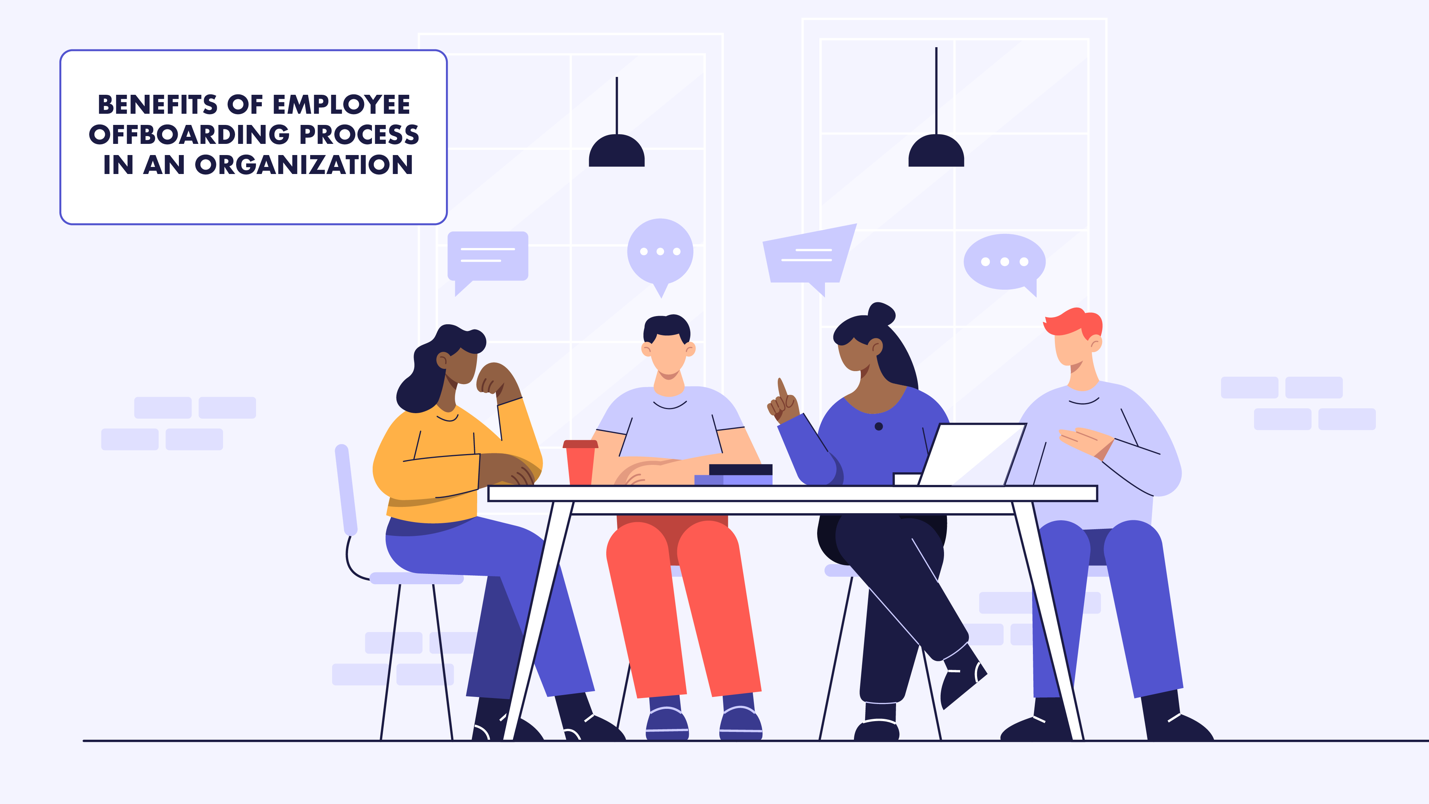
Let’s break down the key benefits of employee offboarding, highlighting why it is crucial for your organization.
Gain Valuable Feedback
Exit interviews are among the best tools for gathering feedback during employee offboarding. HR managers can schedule a meeting before the last day to understand the employees’ viewpoints on the workplace culture, management practices, or operations. Once you identify potential issues within the organization, you can make changes to improve employee retention.
Hire Back Boomerang Employees
Boomerang employees, or those who return to a company after leaving, can bring substantial value. They already know your organizational culture and require minimal onboarding. However, the only way to encourage employees to return is to make them feel valued and create an open-door policy during offboarding. Companies like Deloitte have successfully built an environment where alumni employees can rejoin.
Employee Experience
Think about it: If you organize an exit interview, write a recommendation letter, and provide the necessary assistance your departing employees need, they will leave with a positive impression. Providing a clear offboarding process makes the career transition more seamless. These employees are more likely to write positive reviews about their experience, boosting brand reputation.
Reduces Security Risks
You don’t want to lose sensitive data because you failed to revoke access to company systems. In the same way, you have system access to create a seamless onboarding process; you should implement the same when it’s time for team members to leave. Follow your checklist and ensure you’ve retrieved all company property and secured your internal systems.
Reinforces Employer Brand
Job seekers also scrutinize employers. They research and read reviews about the brand to decide if the company is a good fit. To attract top talent, you need to treat the departing team members well. Offering a positive offboarding experience and proper transition procedure reinforces your position as a good employer.
Ensures a Smooth Transition
Imagine your longest-serving marketing manager just mentioned they are resigning after seven years. What happens now that they hold most of the tribal knowledge? Will the rest of the marketing team struggle to execute their tasks?
You can avoid this by structuring your offboarding process to facilitate a knowledge transfer plan from one employee to the next. With this plan in place, every employee documents key processes so that the new hires or successors can step into the roles immediately without disrupting client projects.
Boosts Employee Morale
The number of layoffs in industries like tech has increased over the years. In addition, a few years back, the “quit rates” increased during the Great Resignation. With so much volatility in the workforce, businesses must demonstrate stability and care for their employees, especially those who remain.
An organized offboarding process can improve morale among remaining employees. Seeing their departing colleagues treated fairly and respectfully fosters a sense of trust and security.
6 Common Employee Offboarding Mistakes to Avoid
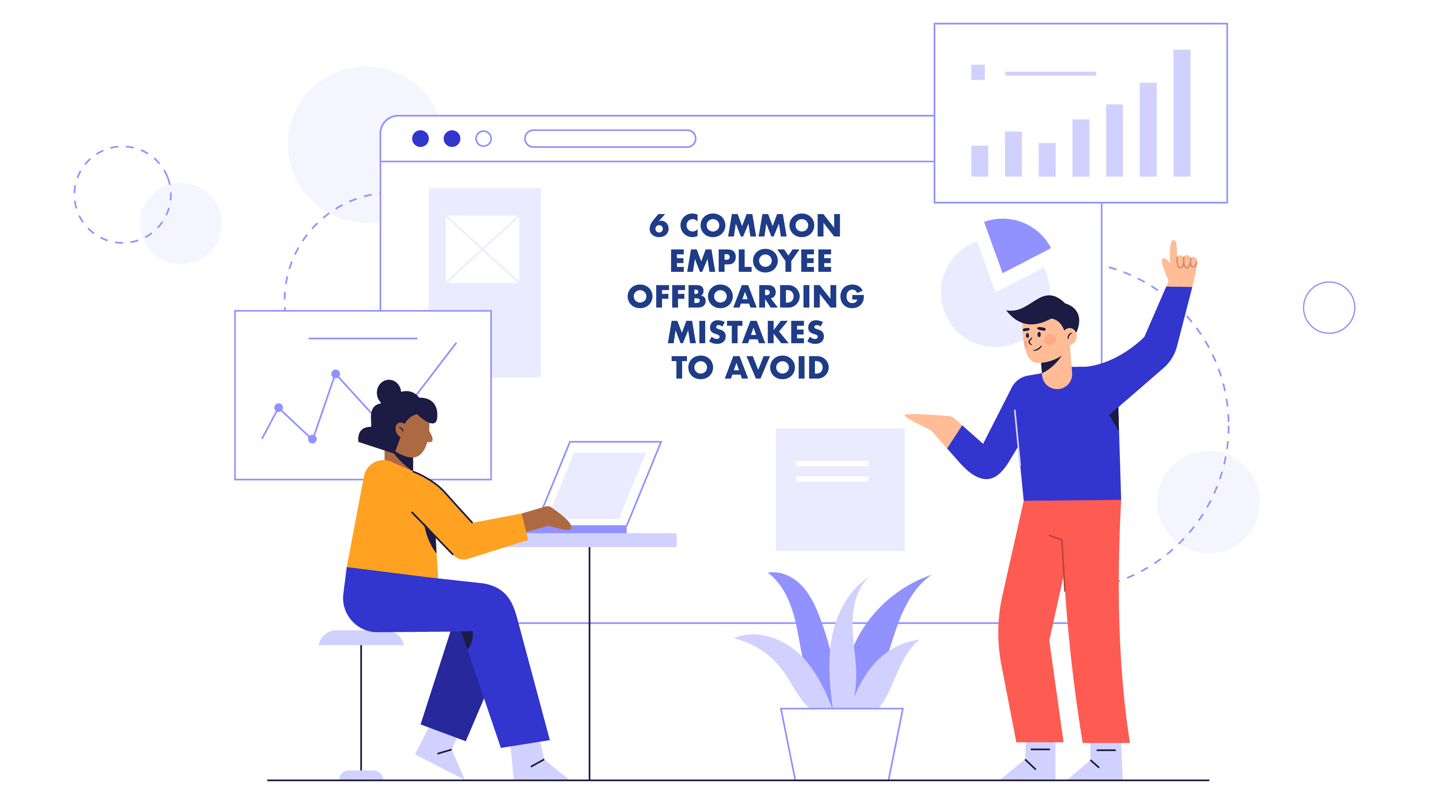
The offboarding process is not always perfect. Here are some of the top offboarding mistakes you need to know and how to avoid them:
Skipping the Exit Interview
Failing to interview the departing employee means missing an opportunity to uncover potential issues. Maybe the employee is resigning because of poor development programs or miscommunication about roles in the department. If you don’t get this information, you might lose more team members in the future, especially if the problem persists.
Lack of a Knowledge Transfer Process
Do you have an existing knowledge transfer process? Are all your workflows and processes documented? Without these tools, you’ll create gaps that could disrupt current and upcoming projects. Your new hires will not have a reference point once they start working. This means you’ll have to spend more time and resources onboarding them.
Neglecting Paperwork
Although paperwork seems like a minor detail, neglecting it could complicate things. For instance, if you don’t follow the due process for termination according to the employee contract, you expose your business to legal issues. An offboarding checklist ensures that you have personnel responsible for completing this paperwork and avoiding costly oversights.
Not Using an Offboarding Checklist
Between running a company and planning for its growth, you might not remember everything when it’s time for an employee’s departure. It’s easy to miss details, such as deactivating accounts, which can lead to security issues. A detailed offboarding checklist outlines all the administrative tasks, ensuring nothing is missed.
Failing to Create a Remote Offboarding Process
Remote working is still a popular working model. As of August 2024, about 35.13 million, representing 22.8% of U.S. employees, worked remotely. Therefore, if you have remote employees in different locations, your onboarding process should also cover these teams. Failing to set up these protocols can lead to disorganization when an employee has to leave.
Lacking Empathy
Whether the employee has quit or been fired, showing respect and empathy is always good practice. As you complete the administrative tasks of onboarding, you can also acknowledge an employee’s long-term service during their exit. A thoughtful exit, such as a farewell message, appreciation for their work, or career support, could leave the door open for future collaboration.
Employee Onboarding vs. Offboarding Process: How Do They Differ?

Employee onboarding and offboarding are two distinct but equally important processes in the employee lifecycle. While both aim to enhance the employee experience, their focus, timing, and objectives differ significantly.
Onboarding involves integrating new employees into the organization. It is typically a welcoming experience designed to help new hires understand the company culture, roles, and expectations.
A comprehensive onboarding program for new employees usually includes:
- Weeks of training
- Introductions to teams and senior management
- Introduction to a mentor who helps guide them through the company’s culture
On the other hand, offboarding occurs when an employee leaves the organization. The process ensures that the departing employee leaves on good terms and that there is business continuity.
Here are the key differences:
| Aspect | Onboarding | Offboarding |
| Timing | Occurs at the start of employment | Occurs at the end of employment |
| Objectives | Integrate new employees into the company | Ensures smooth transition |
| Employee Experience | Creates a positive first impression and engages the employee | Maintain goodwill and gather valuable feedback |
| Focus | Introduction to company culture, systems, and team | Knowledge transfer and company data security |
Manage Your Employee Offboarding Process in One Single Place
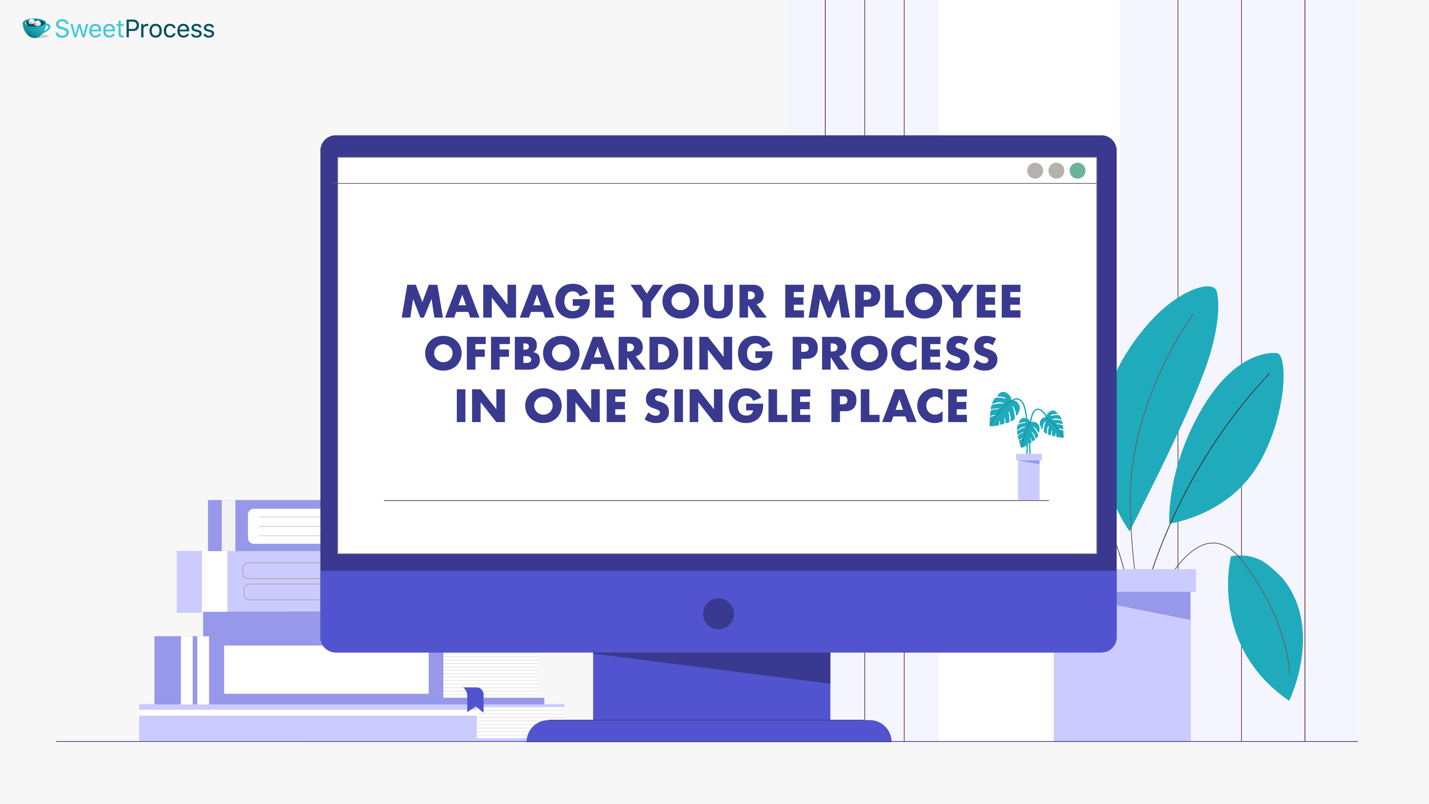
Offboarding is often disregarded, but when executed well, it can be an opportunity to secure your organization’s future while providing departing employees with a positive experience. A structured offboarding process can reduce security risks, help with knowledge retention, and maintain a strong employer brand.
Most importantly, it ensures the employee and the company move forward without hiccups and messy endings.
With a tool like SweetProcess, you can easily track and manage every part of the offboarding journey in one place. You need software to transfer critical knowledge to the remaining team members and a platform to create offboarding checklists.
Simplify your employee offboarding process and ensure your business remains secure and efficient no matter who’s leaving. Start your free 14-day trial with SweetProcess today and take control of every step. No credit card is required!
